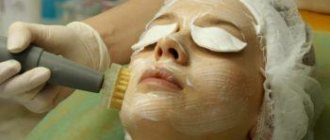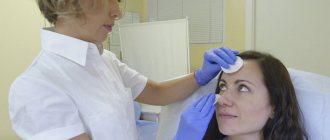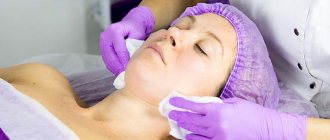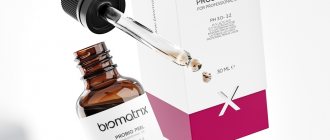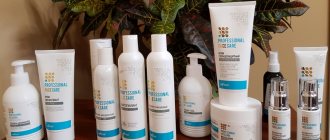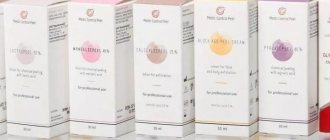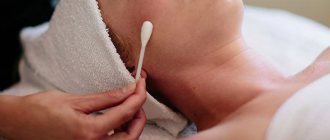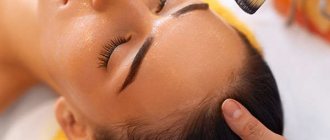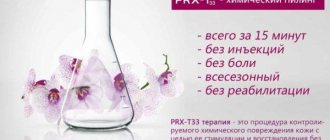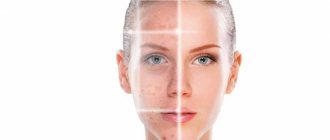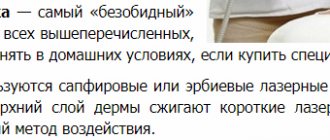What is the difference: home peeling and peeling at a cosmetologist
Peels that can be used at home do not penetrate deeply into the skin and give an unnoticeable result, but they certainly help maintain an even tone and healthy skin. Chemical peels performed by estheticians have a lower pH level than at-home peels, so they can penetrate much deeper into the skin and target skin problems such as hyperpigmentation and acne. Chemical peels can cause redness of the skin; a recovery period will last for several days, during which the “old” skin will gradually peel off and renewed skin will appear.
Chemical peeling performed by cosmetologists will be much more effective for your skin than peeling at home.
Types of chemical skin peeling
Superficial peeling is the most gentle and safe way to refresh and rejuvenate the face, neck and décolleté. The impact is only on the thin stratum corneum of the epidermis (the outermost layer of the skin), so side effects from this procedure are practically eliminated (subject to all rules of post-peel care). When talking about superficial peeling, the expression “weekend peeling” is often used, since rehabilitation takes approximately the same period of time as a weekend.
The method helps improve the color and structure of the skin, is effective in combating acne and seborrhea, but does not guarantee getting rid of deep wrinkles, unevenness, and large age spots. Typically, patients under 40 years of age resort to this procedure to correct minor problems.
Depending on the condition and needs of the skin, lactic and fruit acids (AHA), salicylic acid, glycolic acid or 10-15% trichloroacetic acid are used for superficial peels. Instead of acids, enzymes can be used (enzyme peeling or enzymatic peeling). All these compositions, in addition to exfoliating dead cells, are designed to solve different problems (regulating hydrobalance, reducing pores, increasing tone, reducing inflammation, lightening, etc.), therefore, a cosmetologist can determine which active ingredient is preferable for the patient only after a face-to-face meeting .
Very popular in recent years, retinoic peeling or yellow peeling (active ingredients - retinol, retinoic acid) also belongs to superficial peelings in terms of the type of action on the skin, but is closer in effectiveness to medium peelings.
Retinoic peeling (retinol cleansing) is the choice, for example, when working with mature and/or pigmented skin, as well as skin prone to rashes.
Superficial peelings are usually carried out in courses of 4-6 procedures with a frequency of no more than once a week.
Medium peeling - its effect extends to the entire structure of the epidermis to the basement membrane. This is a very effective procedure, but the patient should be prepared for unpleasant sensations - with medium peeling, the concentration of acids is higher than with superficial manipulations, so the degree of skin damage is greater. The procedure involves further rehabilitation at home for about 7-10 days (due to severe redness and flaking of the skin).
Medium peels usually include trichloroacetic acid (or TCA) at a concentration of 30-40%, salicylic acid, and Jessner's solutions. By exfoliating dead skin cells of the epidermis, these components penetrate into the deep layers of the skin, causing the activity of living dermal cells. The procedure helps restore the protective properties of the skin, improve its turgor, increase density and elasticity. After medium peeling, manifestations of sagging skin go away, wrinkles straighten, scar elements, stretch marks, and age spots are smoothed out.
The procedure is carried out exclusively in the autumn-winter period, since renewed skin becomes especially susceptible to sunlight, and this threatens hyperpigmentation. The recommended course is from five sessions.
Deep peeling is the most impressive in action, but also the most traumatic. This is a serious chemical burn that damages the skin to the point of “blood dew.” This procedure is carried out under anesthesia and only in a hospital setting. The rehabilitation period after deep peeling can take months, but the effect will last for several years.
This procedure is also called phenol peeling because it is performed using phenol (carbolic acid). Under the influence of this substance, the entire stratum corneum of the skin is burned, and with it wrinkles, scars, signs of sagging and sagging skin. The density and elasticity of the epidermis is renewed and restored, and the structure of the dermis is rejuvenated.
Indications for such peeling may include age from 60 years or the presence of significant skin defects.
There is no need to talk about deep peeling as a course procedure because of its high traumatic and painful nature. A repeat is possible no earlier than in a few years.
Since chemical peeling is a radical method, the procedure must be carried out by a highly qualified dermatocosmetologist in a specially equipped medical office!
Indications for chemical peeling:
- biological aging;
- small superficial wrinkles;
- enlarged pores;
- freckles;
- dark spots;
- acne, post-acne;
- melasma;
- lentigo;
- stretch marks (stretch marks);
- sagging skin.
Contraindications to chemical peeling
- cancer;
- poor wound healing;
- tendency to form scars;
- pronounced rosacea;
- infectious diseases;
- dermatological diseases;
- chronic diseases in the acute stage;
- pregnancy and lactation;
- tan, very dark skin;
- recent invasive cosmetic procedures;
- taking certain medications.
1 Superficial chemical peeling procedure
2 Applying regenerating cream
3 Applying regenerating cream
Contraindications:
- The procedure is not recommended for pregnant and lactating women;
- When taking medications based on isotretinoin;
- For herpes and skin diseases;
- When taking antibiotics;
- For oncological diseases;
- For open wounds.
After a chemical peel, the skin is more sensitive to sunlight, so after the procedure it is necessary to use sunscreens and products.
Before the procedure, the cosmetologist must take into account many factors and ask all the necessary questions so that the procedure is as comfortable as possible for the client and gives the best result with the fewest possible side effects.
Retinoic yellow peeling: indications and contraindications
Indications
for the use of retinoic yellow peeling:
- The appearance of small wrinkles;
- Heavy pigmentation caused by long exposure to the sun;
- Loss of elasticity and firmness;
- Insufficient collagen production;
- Acne;
- Skin aging;
- Insufficient skin hydration;
- Hyperkeratosis;
- Need for bleaching;
- Hyperpigmentation.
The retino yellow peel also has several other benefits. It has a lifting effect, gives the skin a smoother appearance and improves relief, removes any impurities from the surface, and stimulates anti-inflammatory processes. The external condition of the skin improves and a healthy glow appears.
Contraindications
for the use of retinoic yellow peeling:
- Allergic reactions that may be caused by the use of retinol;
- Incompatibility with other medications: this peeling can only be done six months after taking Roaccutane.
- The presence of viral infections, which, together with retinoids, can cause a herpes rash;
- Liver disease, as well as previous hepatitis;
- Increased skin sensitivity, which may be indicated by problems such as atopic skin reactions, seborrheic dermatitis, eczema;
- Photosensitivity – high sensitivity to solar or other radiation with a UV component;
- Pregnancy and planning in the coming year, as well as the lactation period;
- Presence of warts.
How is peeling performed and what should you pay attention to after the procedure?
Before the procedure, the skin is cleansed and “degreased”. During the procedure, you will feel warmth and burning on the treated skin surface. To reduce discomfort, you can use a fan or local anesthetic. After peeling, first of all, take care of protecting your skin from the sun, so it is not recommended to carry out the procedure at the height of summer or before leaving for warm countries.
After peeling, you will feel tightness and slight dryness of the skin. The skin may remain red for an hour after the procedure. The condition of the skin in the post-peeling period depends on the type of skin and the type of peeling performed.
It is recommended to avoid excessive physical activity and excessive sweating for several days after the procedure. Do not rub the treated skin area after peeling. Do not use retinol or AXA products for at least 10 days after peeling. Avoid visiting the sauna or bathhouse for several days.
What is retinoic yellow facial peeling?
Everyone knows that peeling is the process of removing dead skin cells using chemicals. In the beauty industry, it is customary to distinguish three methods of peeling : superficial, medium and deep.
.
Superficial peeling only removes particles of skin cells. The second method has a stronger effect, as a result of which the rejuvenation process occurs. Deep peeling
– this is already the most serious procedure, when we get rid of both dead cells and partly living ones.
Recommended articles on the topic:
- Facial mesotherapy procedure: pros and cons
- Beauty injections: types of drugs, reviews
- Placental therapy is the secret of eternal youth
Retinoic
yellow peeling
can be both superficial and medium. In the foreign market, it has long established itself as a high-quality and reliable remedy for solving most facial skin problems. This method has just begun to appear in domestic beauty salons, and many women have yet to appreciate its benefits. In the future, the number of people wishing to undergo the retinoic yellow peeling procedure will continue to grow.
Peeling is called yellow because after it such a shade remains on the top layer of the epidermis. But the skin becomes yellowish only for a short period of time. In most cases, only one procedure is enough to improve the condition of the face. The decision on the required number of sessions always remains with the doctor under whose supervision they are carried out. If necessary, the doctor can prescribe a full course of peeling. Then the patient will have to undergo from six to ten procedures with a break between each of at least ten days.
In cosmetology, retinoic yellow peeling comes in two types. The first of them uses retinoic acid of synthetic origin
. According to the method of penetration, it belongs to the middle, and at the same time has a gentle effect on the skin. After the procedure, she recovers in just a couple of days. Due to this, this type is popularly called the “weekend procedure.”
After completing the session, a woman may feel a slight tightness on her face. The problem is solved with the help of special moisturizers. Also, the skin will have a rich pink color for two days. It will begin to peel off, but after the rehabilitation period it will become smooth and tender.
The main clients who are recommended to pay attention to yellow peeling are people who are already twenty-five years old. Sometimes a similar procedure is prescribed to younger girls if it is necessary to remove marks or scars from acne.
Two weeks before the session, the preparatory stage begins. It consists of starting to use a product that contains retinoic acid of synthetic origin. It is the main component of the peeling. Thanks to two weeks of use, the skin gets used to it, and doctors become confident that the substance does not cause any adverse reactions.
The procedure begins by treating the skin with a solution of glycolic acid, followed by the application of retinoic acid. The components act on the surface of the skin for several minutes and then penetrate deep into it. At the end of the session, the composition is neutralized.
The second type of yellow peeling is using natural retinol.
It can be performed more often than the first option (synthetic acid-based peeling is recommended to be done once every six months). This type of peeling has a milder effect, so it can be used every month.
The composition includes natural retinol, which is obtained from the tropical urukum bush growing in the Amazon. This substance makes it possible to carry out only superficial peeling, the main component of which is kojic acid.
Read material on the topic: Laser facial skin rejuvenation: useful tips and recommendations
Features of yellow peeling:
- Yellow;
- Everyone is used to the fact that acid peels are left on the skin for only five minutes. And this look needs to be kept for ten whole hours;
- Due to the duration of the procedure, cosmetologists do not recommend doing yellow peeling more often than once every six months;
- After removing all the influencing substances from the face, the skin turns red, then begins to peel, and then peels off greatly. This is normal and goes away very quickly.
How retinoic yellow peeling is done in beauty salons
The stages of the procedure itself are as follows:
1.
Preparation period;
2
. Applying a special solution to the face, which contains salicylic and glycolic acids;
3.
Applying the retinoic gel itself. It stays on the skin for a certain time, which depends on two indicators: the degree of acid concentration in the substance and the result desired by the client. Thus, peeling can remain on the skin from 15 minutes to 12 hours;
4.
If the procedure lasts only a short time, the retinoic gel is removed from the face in the beauty salon itself. If the peeling needs to be kept on the skin for several hours, then the client is sent home, and after the required period of time he thoroughly washes his face on his own;
It is worth noting that in this situation, prolonged exposure of the retinoic gel to the epidermis causes fewer problems during the rehabilitation period. The composition for long-term peeling has a lower concentration, which promotes gentle interaction with the skin and less possibility of damage;
5
. Caring care during the recovery period.
Read material on the topic: How to care for facial skin: home care and salon treatments
How to Apply Retinoic Yellow Peel
The procedure begins with the doctor placing the contents of the tube (a mask with a 5-10% concentration of retinoic acid) into a bowl. Next, he evenly covers the patient's face with the mixed mass. No area should be skipped, even the lower and upper areas of the eyelids (along the eyelash edge). The only things that are not peeled are eyelashes and eyebrows. After about 10-25 minutes, the mask will harden on the face in the form of a film. After the required amount of time, which was agreed upon in consultation with a doctor, the mass is removed, the face is thoroughly washed, and then a special sunscreen substance is applied.
In most cases, a retino yellow peel course consists of four procedures. The order of their implementation is as follows: two weeks should pass after the first session, one month after the second and all subsequent ones. Thus, the course lasts two and a half months from the moment of the first peeling. And in total it turns out to be three months, if you take into account the two-week preparatory period. After completing the course, this type of peeling can be repeated every three months to maintain skin condition.
Read material on the topic: Plasmolifting of the face - a breakthrough in domestic cosmetology
What is the effect of medium retinoic yellow peeling?
Retinoic acid, which may be called tretinoin, is the active form of retinol (or vitamin A). Found naturally in plant foods and animal sources. It is able to form bonds with nuclear receptors, with the help of which it triggers a cellular response. It is important to know that almost all cells in the body are sensitive to retinoic acid. To prevent the accumulation of tretinoin in tissues, as this causes side effects, use a mask with a high content of this substance. It needs to be applied once every couple of weeks. As a result, the epidermis will be renewed at the cellular level. Externally, this will be expressed in characteristic peeling of the skin.
Cosmetologists conducted studies that revealed the following pattern: five yellow peeling procedures done every one week are equal in the results achieved to using the cream for six months. It has also been proven that the chance of any adverse symptoms occurring is extremely small. During peeling, retinoids do not harm the skin, do not destroy living cells and do not lead to protein coagulation.
As a result of the influence of active substances on the skin, the following processes occur:
- The level of mitotic activity in basal keratinocytes increases;
- The processes of keratinization, differentiation and melanogenesis are normalized;
- The number of atypical cells is reduced;
- The processes of synthesis of epidermal lipids, as well as components of the intercellular matrix of the dermis, are activated and stimulated.
All this leads to a slowdown in aging and rejuvenation of the skin, its texture and relief are improved, and an antioxidant effect is achieved.
Let us recall the main advantages of retina yellow peeling: the process is absolutely safe, the occurrence of adverse reactions is minimized, the rehabilitation period takes a minimum amount of time, and the effect lasts for four months after the last session.
How to do retinoic yellow peeling at home
1. Preparation for the procedure.
The preliminary stage is very important. Two weeks before the first session you need to start preparing your skin for this event. Do not visit the bathhouse, sauna, solarium or other types of steam rooms. Stop using exfoliators. Replace your cosmetic products with care creams with glycolic acid. They will be needed for the entire preparation period in order to soften the stratum corneum of the skin.
Topical retinoids for peeling are sold in pharmacies. They can be bought without a prescription. For example, the most common are Differin cream, azelaic acid, tretinoin, and benziol peroxide.
2. Application of the product.
Let's start the procedure. First of all, you need to clean your face well. To prepare and soften the skin, apply a glycolic acid solution. Then immediately apply a peeling mask to your face. It is recommended not to remove it for 45 minutes. The time depends on what result you want to achieve.
Unlike other products, Differin cream has the features of application in two stages. The first layer is rubbed into the skin, and the second covers the face more tightly.
3. Finishing stage.
Apply the neutralizing composition directly to the retinoic mask. Now you need to stay in this state for seven to eight hours.
Attention!
Don't be alarmed if you start to feel a slight burning sensation.
This is a normal reaction to the neutralizing mixture, which consists of baking soda and water in a ratio of 0.5:1. After seven to eight hours, you can remove the peeling. Wash your face thoroughly and carefully with warm water and apply a protective, deeply moisturizing cream that is suitable specifically for your skin type.
4. Recovery after peeling.
After undergoing the retino yellow peeling procedure and washing off the mask from your face, you will find that your skin has become very soft and silky. But as time passes (from 12 hours to two days), the epidermis will begin to actively get rid of the dead layer. Sometimes the skin peeling process lasts a week. Under no circumstances should you manually exfoliate the epidermis. The only thing you can do is apply moisturizers, enzyme masks and thermal water. Sometimes persistent hyperemia appears on the face, which will disappear in a couple of days. After exposure to retinoic acid, the face returns to normal after a week.
If you want to achieve the best result, cosmetologists advise taking the full course of this procedure. For retino yellow peeling, the best option is one session every three weeks. The course includes three procedures. The time interval between courses is six months.
5. Care after peeling.
After undergoing the retinoic yellow peeling procedure, the skin requires increased attention and caring treatment. It should be remembered that the epidermis during the recovery stage should not be exposed to ultraviolet radiation. Therefore, do not neglect sunscreen before leaving the house. Every time you go outside, apply a protective product with an SPF filter of at least 30 units.
The skin also needs to restore its water balance. To do this, use special cosmetic products: masks, creams, compresses.
